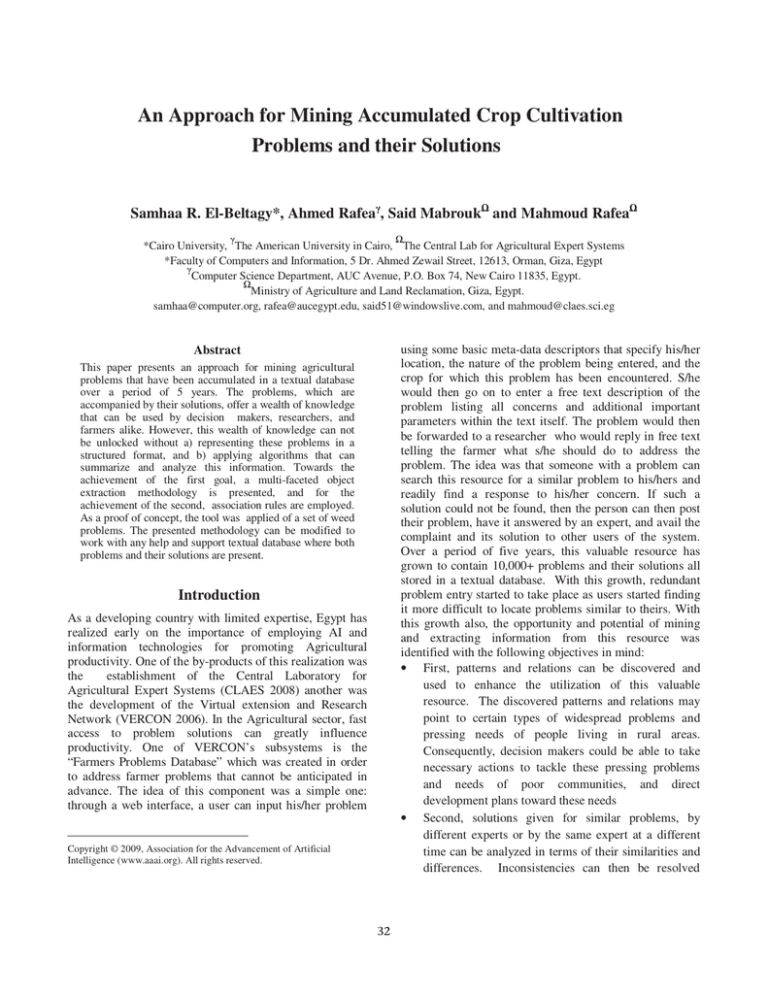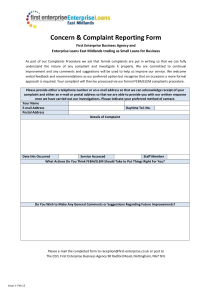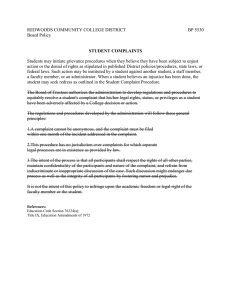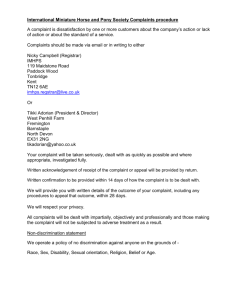
An Approach for Mining Accumulated Crop Cultivation
Problems and their Solutions
Samhaa R. El-Beltagy*, Ahmed Rafea , Said Mabrouk and Mahmoud Rafea
*Cairo University, The American University in Cairo, The Central Lab for Agricultural Expert Systems
*Faculty of Computers and Information, 5 Dr. Ahmed Zewail Street, 12613, Orman, Giza, Egypt
Computer Science Department, AUC Avenue, P.O. Box 74, New Cairo 11835, Egypt.
Ministry of Agriculture and Land Reclamation, Giza, Egypt.
samhaa@computer.org, rafea@aucegypt.edu, said51@windowslive.com, and mahmoud@claes.sci.eg
using some basic meta-data descriptors that specify his/her
location, the nature of the problem being entered, and the
crop for which this problem has been encountered. S/he
would then go on to enter a free text description of the
problem listing all concerns and additional important
parameters within the text itself. The problem would then
be forwarded to a researcher who would reply in free text
telling the farmer what s/he should do to address the
problem. The idea was that someone with a problem can
search this resource for a similar problem to his/hers and
readily find a response to his/her concern. If such a
solution could not be found, then the person can then post
their problem, have it answered by an expert, and avail the
complaint and its solution to other users of the system.
Over a period of five years, this valuable resource has
grown to contain 10,000+ problems and their solutions all
stored in a textual database. With this growth, redundant
problem entry started to take place as users started finding
it more difficult to locate problems similar to theirs. With
this growth also, the opportunity and potential of mining
and extracting information from this resource was
identified with the following objectives in mind:
• First, patterns and relations can be discovered and
used to enhance the utilization of this valuable
resource. The discovered patterns and relations may
point to certain types of widespread problems and
pressing needs of people living in rural areas.
Consequently, decision makers could be able to take
necessary actions to tackle these pressing problems
and needs of poor communities, and direct
development plans toward these needs
• Second, solutions given for similar problems, by
different experts or by the same expert at a different
time can be analyzed in terms of their similarities and
differences. Inconsistencies can then be resolved
Abstract
This paper presents an approach for mining agricultural
problems that have been accumulated in a textual database
over a period of 5 years. The problems, which are
accompanied by their solutions, offer a wealth of knowledge
that can be used by decision makers, researchers, and
farmers alike. However, this wealth of knowledge can not
be unlocked without a) representing these problems in a
structured format, and b) applying algorithms that can
summarize and analyze this information. Towards the
achievement of the first goal, a multi-faceted object
extraction methodology is presented, and for the
achievement of the second, association rules are employed.
As a proof of concept, the tool was applied of a set of weed
problems. The presented methodology can be modified to
work with any help and support textual database where both
problems and their solutions are present.
Introduction
As a developing country with limited expertise, Egypt has
realized early on the importance of employing AI and
information technologies for promoting Agricultural
productivity. One of the by-products of this realization was
the
establishment of the Central Laboratory for
Agricultural Expert Systems (CLAES 2008) another was
the development of the Virtual extension and Research
Network (VERCON 2006). In the Agricultural sector, fast
access to problem solutions can greatly influence
productivity. One of VERCON’s subsystems is the
“Farmers Problems Database” which was created in order
to address farmer problems that cannot be anticipated in
advance. The idea of this component was a simple one:
through a web interface, a user can input his/her problem
Copyright © 2009, Association for the Advancement of Artificial
Intelligence (www.aaai.org). All rights reserved.
32
•
•
•
product (Shi and Chang 2006). (Hu and Liu 2004)
proposed an automatic way to extract product features
from English product reviews using association rule
mining (Agrawal
and Srikant 1994). (Berland and
Charniak 1999) proposed a method to extract “part-of”
type features using possessive constructions and
prepositional phrases from news corpora. (Yi et al. 2003)
extracted both “part-of” and “attribute-of” type features
from online reviews. (Popescu
and Etzioni 2005),
extracted explicit features for a given product class from
parsed review data, and used PMI assessment to evaluate
each candidate feature. (Liu, Wu, and Yao 2006)
presented a method based on identifying all the domainrelated phrases and then divided them into features and
products.
Extracting opinion words that describe a certain feature
is a challenging problem as is the identification of product
features. The opinion word dictionary is typically
generated by collecting adjectives expressing positive or
negative opinions and then automatically searching for
synonyms and antonyms using a semantic lexicon such as
WordNet (Miller el al, 1990) (Hu and Liu 2004). (Liu,
Hu, and Cheng 2005) proposed an Opinion Observer,
from which users can clearly see the advantage and
weakness of each product in the minds of other consumers.
Their work has boosted the development of new techniques
and systems for opinion analysis.
However, this work has to address the handling of
multiple objects and not a single product which is the focus
of most of the current research done in opinion mining.
Using an ontology to discover these multiple objects,
identifying features of multiple objects, and extracting the
words that specify the complaints, outline the main
contributions of this work.
through statistical consensus, which can then be
validated by a domain expert.
Third, patterns of problems and their solutions can be
created and used to classify new problems and provide
solutions without the need for domain experts.
Fourth, outdated recommendations that contain
prohibited material can be easily identified and
removed from the database.
Fifth, users using the complaint database can easily
locate problems that are similar to theirs just by
entering a free text description of their complaint.
But in order to achieve any of these objectives, both the
complaints and the solutions need to be represented in a
structured format. Since the problems and their solution
are presented mainly in text, converting that text into a
more structured format through the use of text mining
techniques has to be carried out first. The challenge lies in
the identification of the complaint object, the features
describing this object, and the complaint features that
specify the focus of a given complaint, and consequently
the discovery of similar complaints written in different
styles.
This paper presents the initial approach and results of
carrying out this task on a subset of problems extracted
from the VERCON problem database. The approach can
be modified to work with any help and support repository.
The rest of this paper is organized as follows: section 2
presents a brief review of related work. Section 3,
provides a closer look at the problem being addressed.
Section 4 provides an overview of the implemented object
extraction process. Section 5, briefly outlines an
implemented prototype that makes use of the extraction
process as well as of association rules. Finally, section 6
concludes this paper and presents future work.
Problem Analysis
By examining a sample of complaints and solutions
entered into the VERCON problem database, it was found
that a single complaint may contain 1 or more primary
complaint objects (explicitly or implicitly specified) often
supported with additional complaint features. An implicitly
implied complaint object, is one that is not explicitly
entered by the complainer, and which is usually deduced
and stated by the expert answering the user’s query. For
example, a user entering a complaint about a disease may
not even know what the disease is and may simply describe
it in terms of symptoms occurring on various plant parts.
An expert would take this, and provide the disease name as
well as advice as to how to address this problem. The
disease in this case, is the primary object of the complaint,
and the symptoms entered by the user are the supporting
features. Each of these features typically describe a specific
plant part, and the extraction process has to differentiate
between these. An expert often describes alternative
solutions rather than one. So extracting each of these
Related Work
This work aims at analyzing growers’ complaints to come
up with causes and features of these complaints and their
solutions. This area of research has some similarity with
opinion mining which appeared recently to assist
customers in product reviews before their purchase as it
became very difficult to go through the huge amount of
reviews available on the web. The growers’ complaints
represent negative opinions about agricultural objects such
as soil, water, climate, plant and others. We can make an
analogy between these multiple objects hidden in the
complaints and opinion mining of products reviews.
Most opinion mining systems rely on identifying the
product features and their possible associated opinions. For
example, the feature “display” is associated with opinion
words like “bright”, “dark”, and “clear” for a mobile phone
33
without confusing features associated with each, is another
one of the extraction challenges. A close look at various
entered problems and solutions revealed that farmers and
experts alike, enter problems and solutions with varying
degrees of details.
The following is an example of typical complaint
retrieved from the textual database of VERCON. The
complaint has been translated from Arabic to English:
template is created. A filled in template would represent a
problem and its solution. So basically, a template specifies
objects that can be extracted from these and their types.
Objects to extract are defined as one of five possible
types: Named entities, time based entities, numbers,
percentages and rates. In this work, the use of an ontology
is instrumental. An ontology plays a major role in the
identification of agricultural objects which are the named
entities of concern in this work. The ontology not only
includes specific objects, but also their associated features
and the possible attributes for these. For the extraction
task, we have used a similar methodology to the one we
had employed for the purpose of text segments annotation
which we also carried out using an ontology (El-Beltagy,
Hazman, and Rafea 2007). Initially, all ontology entries
are read, stemmed, and stored in their stemmed form.
Stemming of Arabic is far more complicated than that of
English because of its inflected nature. Since accuracy of
this step can affect the overall accuracy of the system, we
developed our own stemmer for carrying out this task (ElBeltagy and Rafea 2009).
When parsing an input
complaint (which is actually the complaint and its
solution), the complaint’s text is scanned word by word. A
search for each stemmed version of word is then carried
out within stemmed version of the ontology. If a match is
found, then the concept/object associated with the word, is
said to have been identified. For example, when the word
“ ” is encountered and searched within ontology, it will
be found to be associated with the ‘Weed’ object. The
object and the location where it was encountered (word
number and sentence number) are both stored. This is
important as we define a context window for the
identification of related features. For example, a pesticide
has three related features which are: concentration
(percentage), time_of_Application(time based entity), and
rate_of_application(rate). So, if a pattern matching any of
these features is detected in the object’s vicinity, then its
associated feature can be extracted and the value of its
attribute set.
A number is easy to extract as it usually follows a
known number format. Time based entities can appear as a
number followed by a unit of time (for example, 1 day, 2
months, 3 years), or they can simply be represented in pure
text (for example “after a week”). A percentage entity is
usually a number followed by a percentage mark and is
often a property of a named entity. A rate refers to an
amount of one thing considered in relation to a unit of
another thing (Kilos per Feddan, dollars/hour, etc).
Regular expressions are employed for the extraction of
these four entity types.
When defining an extraction template, a user can
indicate that certain objects are context objects, and can
define context windows for the extraction of their
associated features. Other objects which are features of
this object are associated with this object through a
context field which lists this object as their context. A
There are spots on the leaves and on the spikes which have
a cotton like texture and which turn to grey in some areas
within the planted 25 feddan land.
The main object of the complaint (the disease) is not
apparent in this text, but we need to identify that the
descriptor complaint objects are the leaf and spike, and that
the complaint feature describing either is the spots that
have cotton like texture and a color that is changing to
gray. More formally, the attributes of the spot feature will
be as follows: color = grey, and texture = cotton like. So
if we find the same features in another complaint, we can
predict that these two complaints are similar. However, in
real life it is rare to have two problems with the exact same
features. For example, the following is a complaint that is
similar to the one given above but which has different
wordings and features:
There are white, non-uniform spots with cotton like texture
on the lower surface of plant leaves.
Here the descriptor complaint object is the leaf, and the
feature associated with this descriptor is spots which have
the following attributes: (color = white, texture = cotton
like, location = lower surface, and distribution= nonuniform). The two problems partially match in terms of
problem features as they both have spots on leaves
characterized by the a cotton like texture. However, this
information on its own is not enough to deduce that the
two problems are actually similar.
Looking at the
solutions for both problems, we find that the solution is the
same. We also find the experts responding to the query
both name “Powdery mildew” (which we consider as the
main object of the complaint) as the main cause of the
complaint. So, the solution can actually help in the
production of generalization rules that can both determine
problems that are similar to each other, as well as aid users
with future complaints, in finding solutions to their
problems by either storing a “standard solution”, or simply
displaying similar problems and their offered solutions.
Overview of the Extraction Process
In the textual complaints database, metadata is provided to
classify problems according to the issues they deal with.
For example, typical classifications include “weeds”,
“diseases”, “pests”, “fertilization”, and “irrigation”. For
each of these categories, a hand crafted extraction
34
user can also specify a certain object as the main object
of a complaint (MOC) and another as a main object of a
Textual Complaints +
Solutions
8.
Breakdown of weeds into (wide and narrow weeds)
and their occurrence frequency
Feature
Extractor
Structured Complaints
+ Solutions DB
Extraction Template
and Rules
Agricultural
Ontology
solution (MOS). During the extraction process, a tuple
for each complaint and its solution is created. This tuple,
is replicated each time a new MOC or MOS is
encountered.
Figure1 , shows a simplified
representation of the extraction process.
9.
After the problems and their solutions are stored in a
structured database, further analysis can be carried out
on them using for example association rules.
We were also able to obtain a list of weeds that are
always covered by recommendations issued by the
Ministry of Agriculture as well as another of prohibited
herbicides. When producing any of the above outputs,
weeds that have been reported by farmers, but which are
not covered by recommendations are highlighted in red.
These probably refer to problems that decision makers
aren’t even aware of. Similarly, whenever a herbicide
recommended by an expert matches with one that has been
prohibited, the herbicides name is highlighted in red. But
in this case also, all recommendations advising the use of
this herbicide are relocated from VERCON’s database,
such that users may no longer see this herbicide being
advised.
The relationship between generalized weeds and
herbicides.
Figure 2 shows a sample report representing the
relationship between a given weed and a given herbicide.
Experimental Testbed
A subset of problems dealing with weed associated
problems was selected for the purpose of experimentation
with the proposed approach. The reason this specific class
of problems was selected is due to the fact that they
represent the biggest class of problems in the textual
database. Association rules where applied on the database
created as a result of the extraction process. Various
combinations of features were generated using up to 4 item
sets. The minimum support value, was set to 10% in case
if one itemset, and 5% for all other itemsets. Examination
of the results, led to the selection of a set of potentially
useful patterns and meaningful relationships. These are
outlined as follows:
1. The most frequently occurring weeds and their
occurrence frequency.
2. The distribution of weeds over governorates.
3. The distribution pattern of weed problems among
planting methods.
4. The most commonly used herbicides and their
occurrence frequency.
5. Relationship between a certain weed and a specific
herbicide.
6. Relationship between the control method and
control time.
7. Relationship between herbicides and control times.
35
Berland, M. and Charniak, E. 1999. Finding parts in very
large corpora. In Proceedings of the 37th ACL Conference,
57–64. College Park, Maryland:
Association for
Computational Linguistics.
This result, satisfies the first objective of our work as
stated in the introduction. Work is underway to satisfy the
other 4 objectives.
Conclusion and Future Work
CLAES, 2003. http://www.claes.sci.eg/.
This work has briefly overviewed our used methodology
for transforming the free text of Agricultural complaints
and their solutions, to a structured format. Representing
textual complaints and their solutions in a structured
format and analyzing this information can be useful to
growers, researchers and decision makers alike.
Discovered patterns and relations, can guide researchers to
new previously unknown knowledge that they can further
investigate. They can also point decision maker to
problems that they are unaware of and tell them how
serious these problems are.
Being able to spot
inconsistence in expert advice and resolve this, can lead to
less confusion among users of the “Farmers Problem
Database” and enhance its credibility. More importantly, it
will guide users to actually apply appropriate solutions to
their problems, which will directly affect their
productivity. Having a means for converting free
unstructured text, into a structured form, means that
growers can simply enter their problems in free text and as
a result obtain solutions to problems that are similar to
theirs.
Currently, users of the “farmers problems
database”, are no longer capable to carrying out
appropriate search on the database because of its size, so
they simply enter their problem and wait for it to be
answered by an expert when the answer is often already in
the database. So having such a search interface will
accelerate the response time to a problem, which can again
directly affect productivity.
This work has also shown how the use of the
association rules on extracted information can result in the
production of useful patterns and relations. More work is
currently underway in order to reach the full potential of
this extraction process as outlined by our objectives. Work
is also currently underway to avail extracted patterns and
relations through a web based system, as well as on
expanding our initial prototype to work with other problem
categories.
El-Beltagy, S., Hazman, M., and Rafea, A. 2007. Ontology
Based Annotation of Web Document Segments. In
Proceedings of the 22nd Annual ACM Symposium on
Applied Computing (SAC’07), 1362-1367, Seoul, Korea.
El-Beltagy, S. , Hazman, M., and Rafea, A. 2009. A
Framework for the Rapid Development of List Based
Domain Specific Arabic Stemmers, In Proceedings of the
2nd International Conference on Arabic Language
Resources and Tools, Cairo, Egypt.
Hu, M. and Liu, B. 2004. Mining and Summarizing
Customer Reviews. In Proceedings of the ACM SIGKDD
International Conference on Knowledge Discovery & Data
Mining (KDD- 2004). Seattle, Washington, USA.
Liu, B., Hu, M., and Cheng, J. 2005. Opinion Observer:
Analyzing and Comparing Opinions on the Web. In
Proceedings of the 14th international World Wide Web
conference (WWW-2005). Chiba, Japan
Liu, J. Wu, G. and Yao, J. 2006. Opinion Searching in
Multi-Product Reviews. In Proceedings of the Sixth IEEE
International Conference on Computer and Information
Technology, 25. Seoul, Korea: IEEE Computer Society.
Miller, G., Beckwith, R., Fellbaum, C. , Gross, D. and
Miller, K..1990. Introduction to WordNet: An On-line
Lexical Database. Journal of Lexicography 3:.235-244.
Popescu A. M. and Etzioni, O. 2005. Extracting product
features and opinions from reviews. In Proceedings of
HLT-EMNLP,339–346. Vancouver, B.C., Canada.
Shi, B. and Chang, K. 2006. Mining Chinese Reviews. In
Proceedings of the Sixth IEEE International Conference
on Data Mining - Workshops (ICDMW'06),585-589. Hong
Kong, China: IEEE Computer Society.
Acknowledgments
VERCON, 2006. http://www.vercon.sci.eg.
This work has been supported by the Egyptian Science and
Technology for Development Fund.
Yi, ,J. Nasukawa, T. Bunescu, R. and Niblack, W. 2003.
Sentiment analyzer: Extracting sentiments about a given
topic using natural language processing techniques. In
Proceedings of The Third IEEE International Conference
on Data Mining. Melbourne, Florida, USA.
References
Agrawal R., and Srikant, R. 1994. Fast Algorithm for
Mining Association Rules. In Proceedings of VLDB’94,.
487-499. Santiago, Chile.
36




